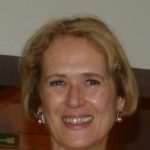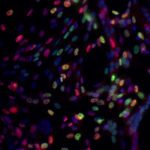Link to Pubmed [PMID] – 17964863
DNA Repair (Amst) 2008 Feb; 7(2): 149-61
Efficient and faithful repair of DNA double-strand breaks (DSBs) is critical for genome stability. To understand whether cells carrying a functional repair apparatus are able to efficiently heal two distant chromosome ends and whether this DNA lesion might result in genome rearrangements, we induced DSBs in genetically modified mouse embryonic stem cells carrying two I-SceI sites in cis separated by a distance of 9 kbp. We show that in this context non-homologous end-joining (NHEJ) can repair using standard DNA pairing of the broken ends, but it also joins 3′ non-complementary overhangs that require unusual joining intermediates. The repair efficiency of this lesion appears to be dramatically low and the extent of genome alterations was high in striking contrast with the spectra of repair events reported for two collinear DSBs in other experimental systems. The dramatic decline in accuracy suggests that significant constraints operate in the repair process of these distant DSBs, which may also control the low efficiency of this process. These findings provide important insights into the mechanism of repair by NHEJ and how this process may protect the genome from large rearrangements.


